The History Of Dodge Dakota

The Dakota is a mid-size pickup truck from the Chrysler LLC's Dodge brand. It was introduced in 1987 alongside the redesigned Dodge Ram 50. The Dakota was nominated for the North American Truck of the Year award for 2000.
The Dakota has always been sized above the compact (Ford Ranger, Chevrolet S-10) and below the full-sized (Ford F-150, Chevrolet Silverado) pickups and Dodge's own Ram. It is a conventional design with body-on-frame construction and leaf spring/ live axle rear end. The Dakota is the only midsize pickup with an optional V8 engine,save for the Hummer H3T. One notable feature was the Dakota's rack and pinion steering, a first in work trucks.
See also Shelby DakotaThe Dodge Dakota was conceived by Chrysler management as the first "mid-sized pickup" combining the nimble handling and fuel economy of a compact pickup with cargo handling capacity approaching that of full-sized pickups. To keep investment low, many components were shared with existing Chrysler products and the manufacturing plant was shared with the full-sized Dodge D-Model. The name Dakota means "friend or ally" in the Sioux Indian language.
The first generation of the Dakota was produced from 1987 through 1996. Straight-4 and V6 engines were offered along with either a 5-speed manual or 4-speed automatic transmission. Four wheel drive was available only with the V6. Both 6.5ft (2m) and 8ft (2.4m) beds were offered. Fuel injection was added to the 3.9L V6 for 1988 but the output remained the same.
In 1988, the Sport package was added as a mid-year release. Available in both 2wd and 4x4, the Sport included:
- AM Stereo / FM Stereo radio with cassette player
- Carpeted logo floor mats
- Center armrest bench seat
- Charcoal/ Silver Deluxe Cloth interior with fold-down arm rest
- Color-keyed leather-wrapped sport steering wheel
- Deluxe wipers
- Dual remote control outside mirrors
- Floor Carpet
- Gauge Package
- Mopar Air Dam with Bosch Fog Lamps
- Mopar Light Bar with Bosch Off-Road lamps (4x4 only)
- Unique bodyside tape stripes
- Euro-style black out grille and bumpers
- Sliding rear window
- 3.9 L V6 engine
- 15" aluminum wheels (5 bolt)
The Sport was available only in Black, Bright White and Graphic Red.
The N-body platform was the result of the identification by Harold K. Sperlich, in charge of Chrysler's Product Planning in the early 1980s, that the Japanese-inspired compact pickups of the time lacked the size and features necessary to meet the demands of American buyers. In the late-1970's, Chrysler was still recovering from their near-bankruptcy and resources were in short supply. Sperlich challenged the N-Body team to search for all opportunities to reuse existing components to create the Dakota. The resulting highly investment-efficient program enabled Chrysler to create an all-new market segment at low cost. Key individuals involved in making this product a reality included Glenn Gardner, Glen House, Robert Burnham, Don Sebert, Jim Hackstedde, and Clark Ewing. The basic Dakota vehicle was ultimately used as a foundation to create the Dakota extended cab version and the Dodge Durango SUV.
1989 saw the unusual Dakota convertible. The first American convertible pickup since the Ford Model T, it featured a fixed roll bar and an uncomplicated manual top. Roughly 2,482 were sold that first year. Another important addition that year was Carroll Shelby's V8-powered Shelby Dakota, his first rear-wheel drive vehicle in two decades.
An extended "Club Cab" model was added for 1990, still with two doors. This model allowed the Dakota to boast capacity for six passengers, although the rear seat was best suited for children and shorter adults.
For 1991, the front of the Dakota received a new grille and hood which extended the engine compartment to better fit the optional 5.2L V8 , which was inspired by the earlier Shelby DakotaV-8 option. By 1992, the standard square sealed beam glass headlamps were phased out for the aerodynamic style molded plastic headlamps attached to the grill surround and equipped with halogen lights. Also debutting in 1991 were the six bolt wheels (replacing the earlier five bolt wheels) based on Dodge's marketing attempting to differentiate the Dakota from competing manufacturers' trucks and the upcoming new Ram introduction.
This engine produced 170hp (127kW). Both of the V-configuration engines were updated to Magnum specs the next year, providing a tremendous power boost. Along with the introduction of the Magnum engine came multi-port Electronic Fuel Injection (EFI). The EFI computer ( called a PCM by Chrysler techs ) was partially responsible for the improved performance. The new engine/ computer combination produced about 235hp (175kW). 1991 was also the last year for the Dakota convertible.
In order to fulfill the Dodge Division's commitment to the American Sunroof Company (who were responsible for the modifications to these trucks), production of the "drop top" Dakota was extended into the 1991 model year. Production was extremely limited, with just 8 produced in total, making them the most rare of all Dakotas. Unlike the previous years, colors and options varied more than before as the manufacturer picked each of these trucks in a somewhat random fashion. No advertising was given to these trucks, and they do not appear in sales literature. This is most likely due to the fact that the majority of them were "pre-sold" before hitting dealer lots.
1994 saw a few minor changes, with the most notable being the addition of a driver's side airbag, located in a new, two spoke design steering wheel (also found in the Ram). Other changes included the discontinuation of the "SE" and "LE" trims. In following with the all new Ram full sized pickups, top end trim was changed to "SLT", with these models (along with select others) wearing the new chrome finshed, styled 6 bolt steel wheels styled similar to the 5 bolt type found on the larger Ram. Other changes included revisions to color and overall trim options.
In 1996, the first generation's final year, the K-based 2.5 L I4 engine was out of production and had been considered vastly underpowered compared to the competition, so Dodge borrowed American Motors' Jeep 2.5 L I4 (rated at 120 hp) and installed it as the base engine in the Dakota. It was the only major change for 1996, and would be also carried over as the base engine in the new, larger 1997 model.
Engines
- 1987-1988 - 2.2L K I4, SOHC, 96hp (72kW)
- 1987-1991 - 3.9L (238cuin) LA V6, 125hp (93kW)
- 1989-1995 - 2.5L (150cuin) K I4, 99hp (74kW)
- 1991 - 5.2L (318cuin) LA V8, 170hp (127kW)
- 1992-1993 - 3.9L (238cuin) Magnum V6, 180hp (134kW)
- 1991-1993 - 5.2L (318cuin) Magnum V8, 230hp (172kW)
- 1994-1996 - 3.9L (238cuin) Magnum V6, 175hp (131kW)
- 1994-1996 - 5.2L (318cuin) Magnum V8, 225hp (170kW)
- 1996 - 2.5L (150cuin) AMC I4, 120hp (90kW)
The second-generation Dakota was built from 1997 through 2004. It inherited the semi truck look of the larger Ram but remained largely the same underneath. 1998 saw the introduction of the R/ T model with the big 5.9L 250hp (186kW) Magnum V8. At the time of its introduction, it was seen as one of the most radical in its class, not only for its styling, but for the fact it remained the only truck in its class with an available V8 engine that rivalled many V8s found in full size trucks and with payload 1300-1500 pounds.
Four-door "Quad-Cab" models were added for 2000 with a slightly shorter bed, 63.1in (160.2cm), but riding on the Club Cab's 130.9in (332.5cm) wheelbase. The aging 5.2L Magnum V8 was replaced by a new high-tech 4.7L SOHC PowerTech V8.
2001 saw a fairly extensive revision of the Dakota's interior, including a completely redesigned dash, door panels and revised seats. Other minor trim revisions were made, including redesigned aluminium wheels on various models.
2002 was the final year for the four-cylinder engine in the Dakota, as Chrysler was ending production of the former AMC design. Most buyers ordered the V6 or V8 engines, which were considerably more powerful and, in the case of the V6, which was made standard for 2003, nearly as fuel-efficient with a manual transmission.
2004 was the end of the old OHV V6 and the big R/ T V8; the 2004 model year vehicles were available with the PowerTech engines, now also used in the third-generation Dakota.
This Generation was also assembled and sold in Brazil from 1998 to 2002.
Engines
- 1997-2002 - 2.5L (150cuin) AMC I4, 120hp (90kW)
- 1997-2003 - 3.9L (238cuin) Magnum V6, 175hp (131kW)
- 1997-1999 - 5.2L (318cuin) Magnum V8, 225hp (172kW)
- 1998-2003 - 5.9L (360cuin) Magnum V8, 250hp (186kW)
- 1999-2000 - 2.5L (150cuin) VM Diesel I4, 114hp (85kW)
- 2000-2004 - 4.7L (287cuin) PowerTech V8, 230hp (175kW)
- 2004 - 3.7L (226cuin) PowerTech V6, 210hp (157kW)
The redesigned 2005 Dakota still shares its platform with the new Dodge Durango SUV (which is now similar to the Ram platform). This model is 3.7in (94mm) longer and 2.7in (69mm) wider, and features a new front and rear suspension, and rack-and-pinion steering. This new generation model also reverted the wheels back to five lug wheels from the prior generation's six lug wheels as cost and assembly time saving measures. There are one V6 and two V8 engines available: The standard engine is a 3.7L PowerTech V6 (specs below); the two 4.7L V8 engines are the standard PowerTech V8 and the V8 High Output or HO. The Dakota is built at Warren Truck Assembly in Warren, Michigan. The 3.7L V6 produces 210horsepower (160kW) and 235ft·lbf (319N·m) of torque. The standard output 4.7L V8 produces 230hp (170kW) and 295ft·lbf (400N·m) of torque. The High Output 4.7L V8 produces 260horsepower (190kW) and 310ft·lbf (420N·m) of torque. Both the 3.7L and standard output 4.7L V8s were available with the 6 speed manual transmission in 2005 and 2006. For 2007, that option was deleted on the V8 models.
In addition to a refresh of the Dakota's styling, the latest generation is not offered in a regular cab model. Only the club cab and quad cab configurations are available. 2006 saw the Dakota R/ T return, however only with cosmetic modifications. Despite the "R/ T" moniker which signifies "Road and Track", the newest Dakota R/ T is simply an option package, characterized by a non functional hood scoop, exclusive gauge cluster, and hockey-stick style side stripes. The package was available on both 2 and 4 wheel drive models.
The facelifted fourth generation Dakota was unveiled at the 2007 Chicago Auto Show. The Dakota gets another facelift and interior upgrade along with a few other upgrades including built-in cargo-box utility rails, heated bench seats, best-in-class towing (up to 7,050 pounds), the largest and longest standard bed in the class, and the largest mid-size truck cab. Its new 4.7 liter V8 produces 302hp (225kW) and 329lb·ft (446N·m). of Torque. The standard engine remains the 3.7 liter V6 with 210horsepower (160kW) and 235lb·ft (319N·m). of torque. Production began in August 2007.
From Wikipedia, the free encyclopedia
More About Dodge Dakota

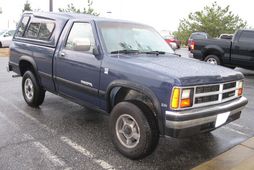


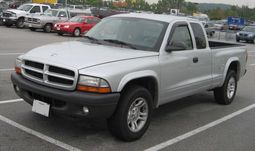
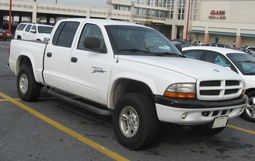

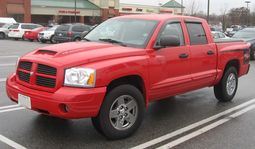
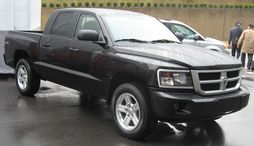
|